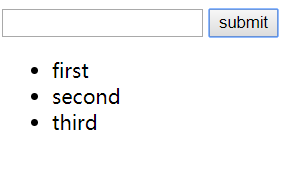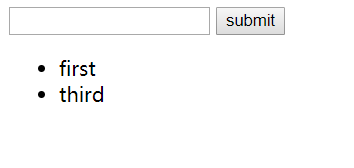用Vue的父子组件通信实现todolist的功能
2019-04-11 09:55:26来源:博客园 阅读 ()

先上代码
<body> <div id="root"> <div> <input v-model="inputValue" /> <button @click="handleClick">submit</button> </div> <ul> <todolist v-for="(item,index) of list" :key="index" :content="item" :index="index" @delete="handle" ></todolist> </ul> </div> <script> Vue.component("todolist",{ props: ['content','index'], template: '<li @click="handleDelete">{{content}}</li>', methods: { handleDelete:function(){ this.$emit('delete',this.index) } } }) new Vue({ el:"#root", data: { inputValue:'', list:[] }, methods: { handleClick:function(){ this.list.push(this.inputValue) this.inputValue='' }, handle:function(index){ this.list.splice(index,1) } } }) </script> </body>
创建todolist的基本结构
1 <div id="root"> 2 <div> 3 <input v-model="inputValue" /> 4 <button @click="handleClick">submit</button> 5 </div> 6 <ul> 7 <todolist v-for="(item,index) of list" 8 :key="index" 9 :content="item" 10 :index="index" 11 @delete="handle" 12 ></todolist> 13 </ul> 14 </div>
在这里我们创建了一个todolist标签作为父组件,让它在里面循环遍历list作为我们的输出,同时定义了一个delete的监听事件。
接下来在script标签里定义子组件
1 Vue.component("todolist",{ 2 props: ['content','index'], 3 template: '<li @click="handleDelete">{{content}}</li>', 4 methods: { 5 handleDelete:function(){ 6 this.$emit('delete',this.index) 7 } 8 } 9 })
定义了一个全局类型的子组件,子组件的props选项能够接收来自父组件数据,props只能单向传递,即只能通过父组件向子组件传递,这里将上面父组件的content和index传递下来。
将li标签作为子组件的模板,添加监听事件handleDelete用与点击li标签进行删除。
在下面定义子组件的handleDelete方法,用this.$emit向父组件实现通信,这里传入了一个delete的event,参数是index,父组件通过@delete监听并接收参数
接下来是Vue实例
1 new Vue({ 2 el:"#root", 3 data: { 4 inputValue:'', 5 list:[] 6 }, 7 methods: { 8 handleClick:function(){ 9 this.list.push(this.inputValue) 10 this.inputValue='' 11 }, 12 handle:function(index){ 13 this.list.splice(index,1) 14 } 15 } 16 })
handleClick方法实现每次点击submit按钮时向list里添加值,在每次添加之后将输入框清空。
而handle方法则是点击删除li标签,这里通过接受传入的index参数来判断点击的是哪一个li
这是删除前:

这是删除后:

总结:通过点击子组件的li实现向外触发一个delete事件,而父组件监听了子组件的delete事件,执行父组件的handle方法,从而删除掉对应index的列表项,todolist中的list对应项也会被删除掉。
原文链接:https://www.cnblogs.com/Filishope/p/10687844.html
如有疑问请与原作者联系
标签:
版权申明:本站文章部分自网络,如有侵权,请联系:west999com@outlook.com
特别注意:本站所有转载文章言论不代表本站观点,本站所提供的摄影照片,插画,设计作品,如需使用,请与原作者联系,版权归原作者所有
- vue.js开发环境搭建教程 2020-03-16
- Vue input控件通过value绑定动态属性及修饰符的方法 2020-03-05
- 详解Webstorm 新建.vue文件支持高亮vue语法和es6语法 2020-02-07
- vue路由跳转时判断用户是否登录功能的实现 2020-01-17
- vue-cli中打包图片路径错误的解决方法 2020-01-17
IDC资讯: 主机资讯 注册资讯 托管资讯 vps资讯 网站建设
网站运营: 建站经验 策划盈利 搜索优化 网站推广 免费资源
网络编程: Asp.Net编程 Asp编程 Php编程 Xml编程 Access Mssql Mysql 其它
服务器技术: Web服务器 Ftp服务器 Mail服务器 Dns服务器 安全防护
软件技巧: 其它软件 Word Excel Powerpoint Ghost Vista QQ空间 QQ FlashGet 迅雷
网页制作: FrontPages Dreamweaver Javascript css photoshop fireworks Flash
